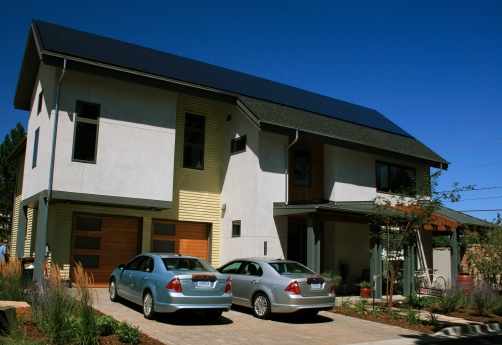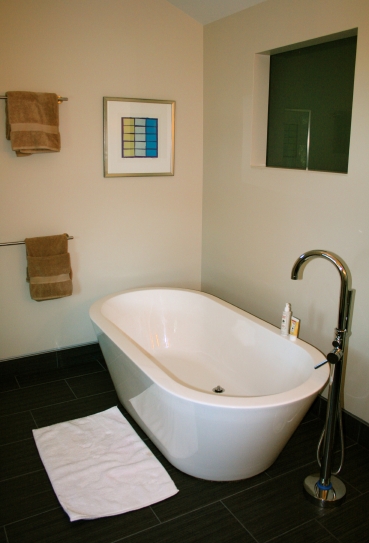A couple of weeks ago, I got the opportunity to join a group of journalists and stay in a “Green House” right here in Boulder. For three days, we got to live a fully environmentally friendly lifestyle—from waking up between organic sheets to driving an electric Ford Focus to using energy- and water-saving appliances.

Located in Boulder, Colo., this net-zero home is powered by solar electricity and cooled/heated by geothermal pumps. Ford hybrid vehicles are parked in front.
The Green House:
The 3,888-square-foot demo home (four bedrooms, four baths) is in the SpringLeaf eco-development in north Boulder, right on Broadway (for incredibly easy access to major bus lines) and in a walkable neighborhood. (It’s just across the street from Lucky’s natural foods grocery store; an organic pizza shop; some other great restaurants; and locally owned coffee shop, video store and a liquor market.)
When finished, there will be a mixture of single-family houses and townhomes in the SpringLeaf eco-community.
Architect George Watt toured us around his super-green creation, which has been certified as LEED Platinum (the highest rating) by the U.S. Green Building Council.
“As earth stewards, we try to minimize our impact as builders on the land,” said Watt while proudly showing us around the beautiful and fairly luxurious home, which proves once and for all that living lightly on the land isn’t restricted to yurts.
Green Building Features:

The Green House's master bathroom contains recycled-content counters, water-saving faucets, organic-cotton towels and Burt's Bees bath gel and lotion.
- The house makes its own electricity from photo-voltaic solar panels, which lie flat on the roof, so you don’t notice them. Usually the home makes more electricity than it uses, which is why it’s called “net-zero energy.”
- A geothermal heating/cooling system uses 300-foot-deep wells to heat the house’s water and to cool the house in the summer and heat it in the winter. This means there are no energy bills to pay—summer or winter.
- Insulation is a high R-value.
- There’s storm-water collection on the home’s roof and a sand filter in the neighborhood’s “pocket” park that cleans oil/impurities from runoff.
- The developers designed the neighborhood around existing mature trees to preserve bird habitat.
- Landscaping uses native and low-water plants and minimal lawn grass. It also incorporates locally quarried stone and beetle-kill wood fencing.
- The permeable driveway allows seepage of water into soil and minimizes runoff.
- The developers recycled the house formerly located on the site that’s now SpringLeaf. The old house is now a halfway house in the nearby town of Erie.
- Low-flow water fixtures curb the house’s water use.
- The stucco exterior requires no maintenance for 50 years
- Windows capture the views of the nearby mountains, plus they allow in daylight so that residents don’t need to use as much electrical light.
- The home is outfitted with Energy Star appliances and energy-saving compact fluorescent or LED light bulbs.
- Cabinets are made of renewable bamboo (solid bamboo, not just a veneer).
- Flooring is wood from Forest Stewardship Council-certified sustainably-harvested forests.
- Finishes (paints, mastics, glues, putties) are all low-VOC, meaning they don’t outgas toxins into the air.
- Carpeting is made from recycled soda bottles or from natural wool and has a natural jute backing
- Doors are solid wood with no formaldehyde treatments.
- Décor includes art from local recycled artist Bruce Campbell, who gets recycled paint for free from Western Disposal and uses it to paint on junk, including old car hoods.
Coming next: Life in the Green House: Tips for Eco-Conscious Living
—Laurel Kallenbach, freelance writer and editor
